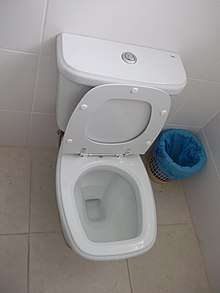Dual flush toilet

A dual-flush toilet is a variation of the flush toilet that uses two buttons or handles to flush different amounts of water.
The system was proposed by American industrial designer Victor Papanek in his 1976 book Design for the real world,[1] but the first practical implementation was designed in 1980, by staff at the Australian sanitary-ware company Caroma.[2] Although the first generation dual-flush toilet caught on, a redesign in 1993 cut water usage in half compared with traditional toilets, when used properly.[2] The dual-flush toilet has since become almost universally adopted in Australia, New Zealand, Singapore, and Israel, with its use in new buildings often mandated by legislation in those countries.[3] However, due to the more complex mechanism, it is more expensive than many other types of low-flush toilets.[4]
Mechanism
Because it is a development of the traditional Australian flushing toilet, the dual-flush toilet differs from siphon-flush toilets in that it relies on gravity to remove waste from the toilet. In addition to its dual-flush feature, the lack of siphoning also means that the toilet requires less water to operate.[4] The lack of siphoning means that the waterline is considerably lower than that in siphon-flush toilets. The main feature of the toilet is the two buttons on the cistern, which release different volumes of water: one button delivers 3 litres and the other 6 litres.[5] The lesser quantity is designed to flush liquid waste and the larger is designed to flush solid waste. It also uses a larger 10 cm trapway in the bowl, allowing for water to come out faster and clear the bowl efficiently.[5]
Advantages
The dual-flush toilet, due to its water-saving ability, has been promoted by the Australian Government under its "Target 155" campaign.[6] The first dual-flush toilets had a 4.5 litre (half) and 9 litre (full) flush, but innovations by Caroma brought that down to 3 litres and 4.5 litres respectively, achieving a WELS rating of 4 and 5 stars in Australia.
Australian governments have used rebates to encourage the replacement of old single-flush toilets with more water-efficient ones.[7] For dual-flush toilets, with a star rating of 4 or higher, owners may be able to qualify to claim a rebate from the State Government in Victoria,[8] New South Wales, or South Australia. Sydney Water’s rebate program ended on 30 June 2011.[9]
Disadvantages
As with most design changes, improvements often involve a trade-off with other factors. In this case, although the toilet achieves its goal of saving water, it may cost somewhat more than a single-flush toilet. If retrofitting in place of an existing toilet, there could be some additional cost involving building modifications, but retrofitting systems have brought the price down significantly, costing about US$30.[4][10]
The lower water level in a dual-flush toilet bowl may be slightly off-putting to visitors to Australia from countries where toilets with a full tank and one lever/button are the norm.
References
- ↑ Papanek, Victor (January 1976). Design for the real world:Human ecology and social change (PDF). Chicago Review Press. ISBN 978-0897331531. Retrieved 25 July 2014.
Because what one does while sitting on a toilet differs in both quantity and quality, it seemed simple to redesign the apparatus so that one could select whether a great deal or only a minimal amount of water was needed for flushing. This concept again was rejected by my client - a man who makes his living manufacturing toilet bowls - as being 'in bad taste'
- 1 2 "Dual Flush Technology". Archived from the original on 2007-08-29. Retrieved 2009-07-08.
- ↑ Household and clothing: Dual flush toilet, Powerhouse Museum. Accessed: 15 February 2015.
- 1 2 3 "How the Dual Flush Toilet Handles Waste". How Stuff Works. p. 2. Retrieved 2009-07-08.
- 1 2 "The Lowdown on Low-Flow Toilets". HGTV. Retrieved 2009-07-08.
- ↑ "Our Water, Our Future". State Government of Victoria. Archived from the original on 2009-05-19. Retrieved 2009-07-08.
- ↑ Toilet Rebates Archived April 18, 2010, at the Wayback Machine.
- ↑ "Our Water, Our Future - Eligible Products". State Government of Victoria. Archived from the original on 2008-07-21. Retrieved 2009-07-08.
- ↑ "Dual Flush Toilet Rebate". Sydney Water. Archived from the original on 2010-02-16. Retrieved 2012-11-19.
- ↑ "Dual Flush Toilet for $30". Archived from the original on 2009-02-11. Retrieved 2009-07-08.